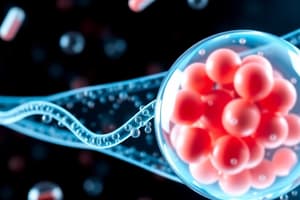Podcast
Questions and Answers
If given to humans, which drug is expected to be the most potent?
If given to humans, which drug is expected to be the most potent?
- Drug 1 (correct)
- Drug 3
- Drug 2
What is the primary focus of pharmacodynamics?
What is the primary focus of pharmacodynamics?
The study of the physiological effects of drugs at different concentrations.
What does pharmacokinetics study?
What does pharmacokinetics study?
The movement of drug in the body.
Emax refers to the maximum effect a drug can achieve.
Emax refers to the maximum effect a drug can achieve.
Pharmacology is the study of ______.
Pharmacology is the study of ______.
Match the following terms with their definitions:
Match the following terms with their definitions:
In the context of enzyme inhibition, what is the relationship between IC50 and potency?
In the context of enzyme inhibition, what is the relationship between IC50 and potency?
Which drug administered via intravenous (iv) route showed the highest relative measure of effect?
Which drug administered via intravenous (iv) route showed the highest relative measure of effect?
Flashcards are hidden until you start studying
Study Notes
Drug Development and Testing
- Medicinal chemists synthesize new drugs for potential therapeutic applications.
- New drugs developed target HDL cholesterol through enzyme inhibition.
In Vitro Testing Results
- Drugs tested for enzyme inhibition measured using two indices:
- IC50 (nM): Drug 1 (0.01), Drug 2 (0.05), Drug 3 (1)
- Emax (%): All drugs achieve 100% efficacy.
- Drug 1 is expected to be the most potent in humans based on in vitro IC50 values.
Efficacy vs. Potency
- Efficacy refers to the maximum effect a drug can produce (Emax).
- Potency is described by the IC50 value; lower IC50 indicates higher potency.
- After administration, differences in drug effectiveness projected (iv vs oral) suggest variance in relative effect measurements.
Pharmacology Definitions
- Pharmacology: Study of drugs (derived from "pharmac-" meaning drugs, and "-ology" meaning study).
- Pharmacodynamics: Examines physiological drug effects at various concentrations.
- Pharmacokinetics: Investigates drug movement and disposition within the body.
Interaction of Pharmacodynamics and Pharmacokinetics
- Pharmacodynamics describes the impact of the drug on the body (e.g., drug-receptor interactions leading to physiological changes).
- Pharmacokinetics reveals how the body affects a drug throughout its lifecycle—administration to clearance.
Time-Concentration Relationship
- Pharmacokinetics depicted through concentration vs. effect relationships.
- Example of drug mexiletine shows serum concentration correlations over time.
- An increase in drug concentration typically improves physiological effect until a saturation point is reached.
Amiodarone Case Study
- Amiodarone illustrates the pharmacodynamic response relative to its interaction at drug action sites.
- Integrating pharmacokinetics and dynamics is essential for understanding the overall drug response in clinical settings.
Studying That Suits You
Use AI to generate personalized quizzes and flashcards to suit your learning preferences.



